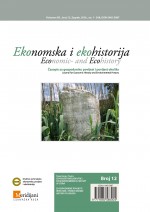Voda, ogenj in potresi kot zaviralni elementi v razvoju mest in trgov v predmoderni dobi - primer osrednje Slovenske dežele Kranjske
Water, Fire and Earthquake as Hindrance for the Development of Towns and Market Towns in Pre-Modern Era- the Case of the Central Slovenian Province Carniola
Author(s): Boris GolecSubject(s): Regional Geography, Modern Age, Rural and urban sociology, Economic development, 13th to 14th Centuries, 15th Century, Financial Markets
Published by: Društvo za hrvatsku ekonomsku povijest i ekohistoriju - Izdavačka kuća Meridijani
Keywords: water; fire; earthquake; towns; market towns; Carniolia;
Summary/Abstract: The basic question of this paper is how, and to what extent, the three natural elements - water, fire and earthquakes – hindered development of towns and marketplaces of the central Slovenian country Carniola in the pre-modern era. A special attention is given to spatial changes, economic and social situation of the so-called civil settlements. The studied factors cannot always or exclusively be referred to as destructive, because they could have a positive effect, too. The dual role and effect primarily belongs to water, but in some case, the effects of fire and earthquake could also have stimulating effects on development of certain settlements. In Carniola towns and marketplaces, we see that water primarily was an incentive factor for their development. Of course, in numerous cases, water was an adverse or destructive element, but not as strong as fire, since the vast majority of civil settlements of Carniola was not at risk of flooding. Frequent flooding in its lower reaches was caused by the two largest rivers, Sava and Krka, each of which at least once in the pre-modern era had changed the city views Kostanjevica and Krško. Interestingly enough, these two were the only Slovenian cities that have never been surrounded by walls. Due to its specific geographical position on Krka river island, Kostanjevica today is more vulnerable to floods and hydrographic changes (more exposed than the other town, Krško). Over time, Krka river has noticeably changed its flow, taking away parts of the river island in several places, while some sand drifts slightly increased. The cartographic sources between 17th and the first half of the 19th century witness the entire island thinning in width. As for the town of Krško, in period from the late 17th to the mid 18th century, Sava river swallowed several small houses on its right bank. Fire, on the other hand, was an incomparably greater destructive factor than water. When studying the effects of fire on spatial, economic and social picture of the fire-affected settlements we encounter more problems, primarily because fires were poorly/insufficiently documented. A burned down village, if structurally built good enough, could easily recover its economy and demographics. Depopulation and long economic stagnation or crisis rarely appeared only because of the fire, with no connection with other negative factors. Fires caused major demographic, economic and social hardship in economically and structurally less stable microenvironment. This is the case of Kostanjevica, an extremely rural town, where the early 18th century fire significantly contributed to depopulation (reducing the number of houses and inhabitants); however, in 1744 the last major fire brought a turning point in the opposite direction. The link between structural weaknesses and fire undoubtedly had the toughest consequences of the marketplace Otok-Gutenwerd. Its decline had started in 1365, since a nearby town Novo Mesto developed; a hundred years later, (in 1473) the incursion by Turks and their burning the town down was the last blow after which the settlement was never rebuilt. The effects of fire on spatial situation of urban settlements and marketplaces are more difficult to establish for the period prior to the formation of town views and especially before sufficiently precise layouts and blueprints came to the archives. A more radical intervention in the land subdivision was done in a micro space that changed its functional purpose. For example, in a well-documented earlier period we notice a significant intervention in the city of Ljubljana after a 1774 fire and in Kranj after an 1811 fire. From the studied natural factors, earthquakes had the least effect on Carniola territory. Sadly, the 1511 earthquake, the biggest one there, is only sparsely documented in contemporary sources. In one of the medieval earthquakes after year 1261, a stone avalanche reportedly demolished a marketplace Ljubelj on Karavanke foothills, whose successor should be the marketplace Tržič.
Journal: Ekonomska i ekohistorija - Časopis za gospodarsku povijest i povijest okoliša
- Issue Year: 2016
- Issue No: 12
- Page Range: 197-207
- Page Count: 11
- Language: Slovenian

